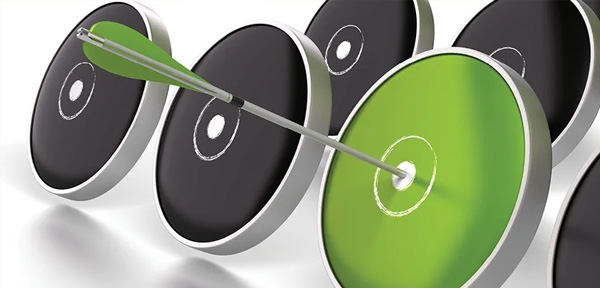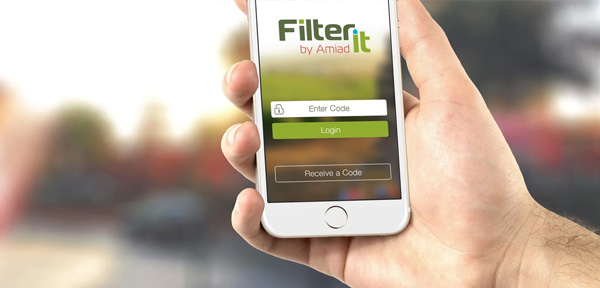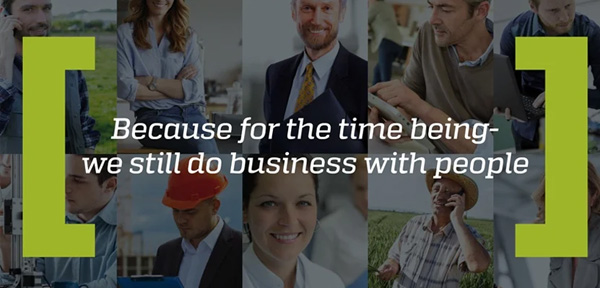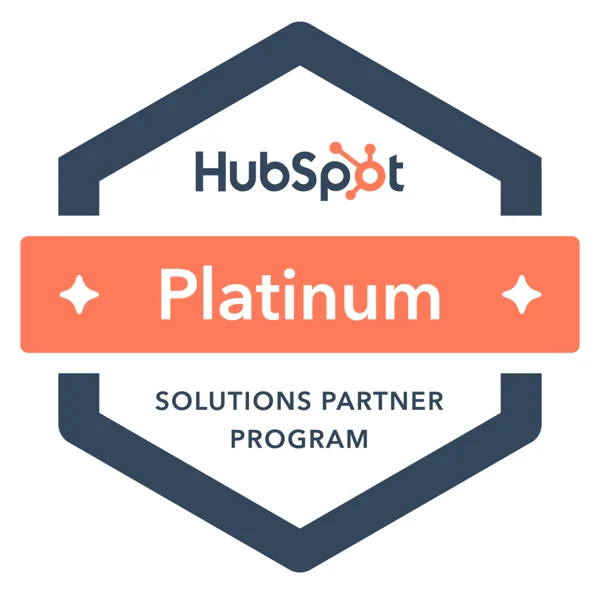Miri Peled Recent Posts
Rebranding – so much more than just a logo or color palette
By
Miri Peled
, 19/02/2018
Rebranding – so much more than just a logo or color palette. What you'll need to do when rebranding.
Refresh or rebrand?
When rebranding, you can either refresh and improve your current branding or start over and create an entirely new one. No matter what you decide, the rebranding process involves a lot more than designing a new logo or changing your corporate color palette. Here’s what you’ll need to do:- Defining a clear rebranding strategy.
- Reanalyzing your company’s vision, mission and values.
- Conduct market research and competitor research including new players who may have popped up more recently.
- Research existing customers, potential customers and target audiences.
- Redefine your message.
- Create a new visual identity.
- Create new marketing materials.
- Relaunch your brand (internally and externally).
Spreading the news
The rebranding journey can sometimes be confusing for your employees and customers who have become accustomed to your existing brand identity. Use this as an opportunity to reconnect with them and clearly communicate during the process and after its completion. If you want the transition process to be a success, you should be as transparent as possible and clearly communicate these changes both internally and externally.Rebranding with OZ
At OZ, we understand the complexity of rebranding and our team has extensive experience helping our customers successfully navigate the rebranding process. We can use this experience to successfully guide you through it from planning through to implementation and beyond.Moo-ving it up a notch with user experience
By
Miri Peled
, 10/10/2017
To encourage Afimilk’s dealers to make more purchases online and to give them access to marketing materials, OZ designed an intuitive online partner portal.
Afimilk case study: partner portal
In the world of B2B, it’s really important to nurture partner relationships and find ways to make it easier for our partners and distributors to satisfy the needs of their (and our) end customers. In this manner, you can create a win-win situation where both your customers (distributors) are happy and their customers (end users) are happy with your brand. Recently, as part of our ongoing services for Afimilk – a global leader in advanced dairy management technology solutions – we created a unique and creative solution for its partners. With the goal of encouraging Afimilk’s dealers to make more purchases online and give them easy access to marketing materials, we designed an integrated and intuitive online partner portal. This portal provides end-to-end marketing and sales support, and an easy-to-use online ordering system. It includes three valuable tools that are also integrated with Afimilk’s ERP system:- Knowledge center – with marketing resources including brochures, presentations, and supporting materials to help dealers promote Afimilk solutions.
- Configurator wizard – builds price quotations tailored to customer requirements while promoting Afimilk’s preferred solutions.
- Market gate – intuitive online ordering system tailored for Afimilk partners to encourage online ordering.
It’s all about the people and building relationships
By
Miri Peled
, 09/08/2017
We worked together to develop a new visual identity that stands out in the global market and is also centered around Trendlines’ two foundational principles.
It’s about the people AND building relationships
Because Trendlines Group’s hands-on investment approach and commitment to improve the human condition through innovation are inseparable parts of the company's character, the refreshed visual identity rests strongly on these principles. The result – a new compelling brand and visual identity – was launched at Trendlines’ 7th Annual Trendlines Company Showcase attended by hundreds of biomedicine industry professionals from around the world, and sponsored by companies worldwide.Inbound for Medical & Healthcare Companies Event
By
Miri Peled
, 23/07/2017
We held an Inbound for Medical & Healthcare Companies event where industry experts shared multiple insights on marketing for medical and healthcare industries.
- Matt Brown, HubSpot Specialist from Boston – US Trends in Healthcare Marketing
- Dina Gidron, VP Strategy at OZ – Opening New Channels of Communication
- Mickey Nave, Corporate Marketing Director at Lumenis – Medical marketing: generating leads that your sales team will love
- Bat-chen Grinberg, Founder of MC Forum – Digital tools that reduce your work overload
- The age of “Social Health”. The combination of healthcare reforms, the age of consumerism and mobile technology is creating the perfect climate for change in healthcare.
- We see YOU, we know YOU, we understand YOU, we want to help YOU. The digital revolution is transforming the way we do business as we shift from a Business-to-Business (B2B) to a Business-to-Business-to-User (B2B2U©).
- Patient-consumers are the center of the universe. As patient-consumers become the single most important factor in this new era, we need to open up direct channels of communication with them to understand their challenges, increase brand awareness and create bottom-up demand.
- Trends in medical and healthcare. Patient-consumers are avid researchers; marketers are targeting patient-consumers AND payers; digital channels are overtaking traditional marketing channels; and digital content is key to the decision process.
- Brands must recognize social health and deliver value across the full spectrum to drive leads, convert prospects to customers and keep them loyal.
- Inbound marketing and content marketing are well-suited to the medical and healthcare industry as it promotes targeted communication, trust-based decision-making, long-term relationships, and thought leadership and industry expertise.
What’s the difference between traditional and inbound marketing?
By
Miri Peled
, 29/06/2017
Inbound marketing focuses on attracting customers through valuable content, while traditional marketing is marketer-centric and uses more interruptive methods.
It's time to attract your prospects instead of bombarding them.
Inbound marketing is a customer-centric approach that focuses on attracting customers to your business through content and interactions that are valuable, helpful, and trust-building.It’s all about using remarkable content to develop and nurture long-term relationships with your prospects so they ultimately build trust in your brand.
In comparison, traditional marketing, which is marketer-centric, uses more interruptive methods to vie for the attention of prospects.| Inbound | VS. | Outbound | |
| Definition | Inbound marketing uses customer-centric tactics to attract prospects, address their challenges and goals, and build trust in your business | Traditional marketing uses more interruptive methods to push products and services and get the attention of prospects | |
| Communication | Based on interactive communication that engages prospects and attracts them to you | Based on one-way, outward communication | |
| Tools/techniques | Educational content such as blogs, videos, eBooks, white papers, SEO, and case studies | Print and TV ads, banner ads, direct mail, cold calling, and mass email campaigns | |
| Goals | Offer prospects value through educational content and earn their trust | Drive sales through product-centric marketing |
Getting creative in B2B marketing
By
Miri Peled
, 15/05/2017
Yes, branding is vital to success. But what about lead generation, which is also crucial to business and requires creative methods to bring in qualified leads?
The changing role of CMOs in B2B marketing
By
Miri Peled
, 15/05/2017
Customer empowerment has led to a changing CMO role as CMOs become the customer voice within their organizations. But what does this role actually involve?
The customer leads the way
With digital disruption and an ongoing increase in Internet and social media usage, consumers now have almost all the information they need at their fingertips. In fact, research shows that the majority of customers engage in online research and brand comparison before they commit to a specific product or service — even (and often especially) in the world of business to business (B2B) — and continue to use online platforms at multiple points across their buyer journey. This has far reaching effects on the marketplace, and businesses are being forced to adapt their marketing strategy accordingly. Instead of interruptive marketing fighting for a customer's attention and money, twenty-first century businesses need to focus on both offline and online marketing to attract potential customers, increase sales and maintain an ongoing relationship with their customers.Expanding the CMO’s Role
These changes to customer behavior, as well as the ability of companies to reach a more diverse and global customer base, have led to an expansion or even a complete redefinition of the CMO’s role, in both B2C and B2B marketing. As advocators for customers — or the “voice of the customer” —CMOs will need to lead changes across companies. This involves playing a more active role in areas such as global branding strategy and public profile, product development, leading the move from a product-centric to a customer-centric model, content planning and generation, digital media, and more.Using online marketing to generate a buzz (or a moo)
By
Miri Peled
, 15/05/2017
When Afimilk was preparing to launch its new AfiLab, the company turned to Oz Branding for assistance in creating a combined online and offline campaign.
Afimilk case study: all you need is lab
When Afimilk — a pioneer and global leader of management technology for dairy farming — was preparing to launch its In-line Milk Lab internationally, the company turned to Oz for assistance in creating a combined online and offline campaign for the launch.- Online – including digital ads in a variety of professional magazines, a social network campaign that was launched 6 weeks before the expo, the creation of a specific AfiLab mini-site, blog posts on the subject, a newsletter, a PR, and more.
- Offline – including brochures, a booth at the trade show, giveaways, printed ads, and more.
The Online Approach to Event Marketing
By
Miri Peled
, 14/05/2017
This post will explain how to effectively integrate the two to achieve your company's greater marketing goals when it comes to marketing a conference
1. The More Targeted the Event, the Better
At an industry conference, you want your booth and company to really stand out among the others. The larger the conference and broader the topic, the more challenging it will be for your product to grab the attention of potential customers. One of our customers, Elcam Medical, for instance, started to see fantastic results after attending more targeted events. After undergoing a branding process which sought to position the company as experts in ensuring safety in the hospital environment, they understood that they were marketing not only to their supplier, but also to their end user -- ICU nurses. You can read more about Elcam's success in integrating online and offline marketing strategies here>> As a result, instead of attending the usual larger medical conferences and trade shows, they began to attend more targeted professional conferences of nurses, albeit with a smaller booth. Since the subject was so targeted, Elcam Medical was often able to generate awareness of their product by speaking on the lecture panel at the conference.2. Be Really Clear About Your Inbound Goals
Make sure everyone in your marketing department is working together towards the same goals. Your inbound marketing activity before, during, and after events can support your greater marketing strategy of lead generation by:- Increasing both direct and indirect traffic to your company website
- Increasing the number of email or blog subscribers
- Educating potential customers about your specific product or service
- Increase the number of requests for a product demo
3. Identify your Call-to-Action (CTA)
A call-to-action, or CTA, is an action which you want potential customers to take. This is the method by which you achieve your goal, which you've properly defined in #2. Your CTA could be to convince potential customers to register for the event, download your ebook or white paper, sign up for your webinar, take a survey, or just visit your latest product or service page. By convincing potential customers to take this action, you are driving them further along the sales cycle. Other parts of your company can benefit from trade shows as well, so it is important to sit down and brainstorm with management in different departments to get their input. One of our clients, Afimilk, decided that in order to promote their new product, the AfiAct II at the World Dairy Expo, they would run a lottery during the event to give away the product to one lucky registrant for free. We integrated a CTA into all of their marketing materials for this event, adding it to the Afimilk website homepage, and creating landing page dedicated to registrations specifically for the event.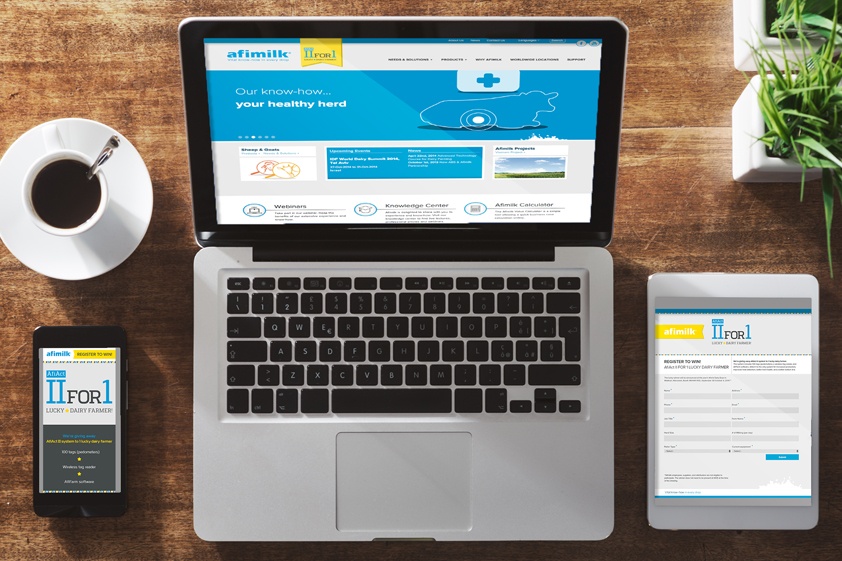
4. Create a Dedicated Landing Page to Promote your Event
The best landing pages promote events before and after the event. How? Before the event, they help to schedule appointments with your sales and marketing team, explain exactly what your company will be doing at the event, and promote a particular product or service. After the event, they publish reactions and insights from the event as well as the speaker's presentations on the landing page. Another purpose of your dedicated landing page before the event can be to get specific info from potential customers in order for your sales team to qualify them. But in an environment where you are competing with many other companies for the attention of the same people, you'll need to stand out from the crowd. Why would they want to give you information about themselves? You'll have to offer them something in return. Think really hard about what your potential customer's pain point is and how you can help them – for free, in exchange for their contact information. Here's an example from one of our customers, Plastopil, where we inspired customers to register to an event by offering them a free iPad mini: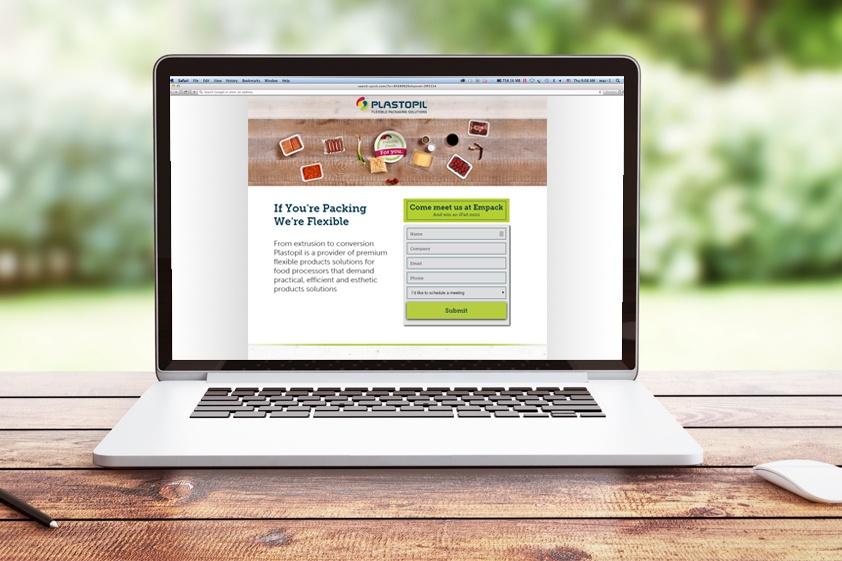
5. Promote Your Event via Email Marketing
Invite your contacts to the event with an email beforehand, sending them to your dedicated landing page in order to register for the event or schedule appointments, educating them about your services and products, or offering them a free ebook or white paper to show them you understand (and have a solution to) their main pain point. You may want to send an email promoting the event several times beforehand – perhaps a month, two weeks, and then the week of the event. Follow up afterwards with either a thank you or a newsletter that recalls the event. If you blogged about the event, include those posts in the newsletter as well.
Follow up afterwards with either a thank you or a newsletter that recalls the event. If you blogged about the event, include those posts in the newsletter as well.
6. Combining Online and Offline for Maximum Results
A major goal in B2B conferences is to build new business relationships and strengthen old ones, both of which are key in lead generation. This offline approach should not be underestimated. However, you can use inbound marketing to gain the attention of new potential business partners, educate them about your products and services, and have that first meeting be as effective as possible.Should I Still Speak to My Customers Face-to-Face?
By
Miri Peled
, 14/05/2017
Are you struggling to find the right marketing mix? Get some tips on creating an offline marketing strategy that is complemented by your online strategy
Integrating online and offline marketing
With all of this focus on online marketing, we tend to think that we should invest all of our energy in our online presence. But it’s not that simple as customers don’t only spend their time online. While online marketing is crucial to growth and success, you need to also engage your customers using offline methods – especially in B2B industries where long-term relationships with customers are crucial to success. A good way to understand this is to compare it to the use of social media in our personal lives. Most of us frequently share personal information about ourselves, our families, our hobbies, and more, on social media platforms. Despite the fact that these platforms seem to “replace” direct relationships, that’s not usually the case, and most of us still make a lot of effort to meet with our families and friends on a regular basis to nurture our inter-personal relationships. If we apply this example to business, we can build well-balanced marketing strategies by combining the use of social platforms to share knowledge with potential customers and build their trust, with inter-personal, offline interactions.
Not mutually exclusive
Using both online and offline marketing doesn’t mean that you need to create separate strategies for each. Instead, you need to create the right marketing mix for your company and field where your offline marketing strategy is actually complemented by your online strategy, and vice versa. Here are some examples:1. Trade shows
Trade shows may be traditionally associated with “offline” marketing, but you can leverage your investment in them by using a digital strategy to promote your company’s presence at the event. This can be done through digital ads, social media campaigns, landing pages, calls-to-action, and even webinars or videos talking about the upcoming event and where to find you. These promotions can be used to both promote your business in general, and to set up meetings or collect quality leads.At the event, you’ll be able to meet these potential customers (and other) face-to-face and most importantly, to follow up after the event based on what they told you about their specific needs. Again, the follow-up communication can be done through both direct communication and digital communication such as newsletters.
Read here about the online approach to event marketing>>
2. Samples to customer
Offer potential buyers and distributors that leave their contact details via digital platforms free samples of your products (where relevant) or promotions. In this manner, you can collect quality leads from customers, communicate with them directly to get them to try your products, and continue to engage with them through online campaigns. You can also use geo-driven campaigns to attract potential buyers and then refer them to local points-of-sale.
3. Digital campaigns and demos
Use digital campaigns and landing pages to encourage potential buyers to leave their information and then call them to set up a live demo of your product. You can continue to nurture the relationship with these potential buyers after the demo through a combination of offline and online marketing techniques.
4. Join social media groups
Join and contribute to social media groups in your field, use them to increase your brand awareness, and look out for offline networking initiated by these groups, including impromptu meet-ups and offline conversations. You can also initiate such offline events in order to meet potential leads face-to-face.
The best of both worlds
So the answer is yes – you should DEFINITELY still speak to your customers face-to-face, and communicate with them in every way possible to secure and nurture long-term trust and relationships, and meet their specific goals and needs. To get the most out this combined approach, make sure your brand promise, messaging, and visual language is consistent across all platforms so that your potential buyers and promoters recognize you wherever you are.Creating an Exceptional Digital Experience for Millennial Buyers
By
Miri Peled
, 14/05/2017
Exceptional Digital Experience. millennial buyers have the first digital contact and are determining which vendors should even be considered by the C-suite.
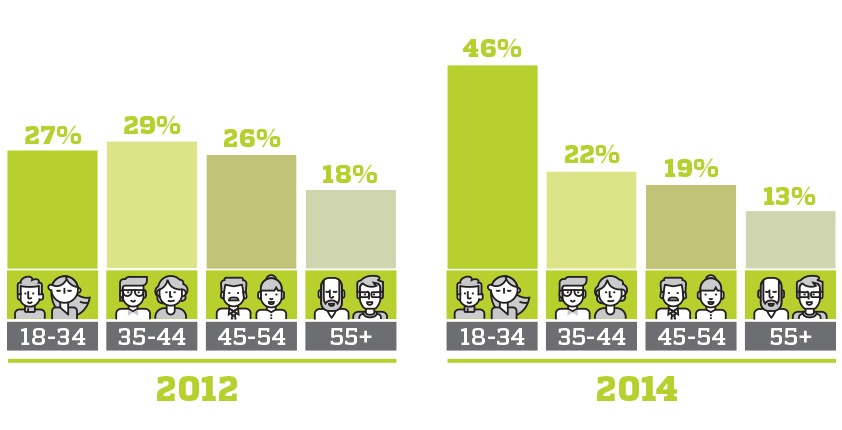 Image by Google/Millward Brown Digital, B2B Path to Purchase Study, 2014
According to an IBM study, millennials value a hands-on, authentic experience with a brand. The challenge for B2B organizations, therefore, is creating a relevant, seamless digital experience that millennials can connect to – at the right time and in the right digital channel.
That's why an exceptional digital experience for all of your customers, including millennials, is so crucial. Since a CEB study found that buyers are now as much as 57% of the way through the buying process before actually engaging with a seller, you need to create a lasting impression that will raise your vendor to the top of the list.
Image by Google/Millward Brown Digital, B2B Path to Purchase Study, 2014
According to an IBM study, millennials value a hands-on, authentic experience with a brand. The challenge for B2B organizations, therefore, is creating a relevant, seamless digital experience that millennials can connect to – at the right time and in the right digital channel.
That's why an exceptional digital experience for all of your customers, including millennials, is so crucial. Since a CEB study found that buyers are now as much as 57% of the way through the buying process before actually engaging with a seller, you need to create a lasting impression that will raise your vendor to the top of the list.
How can your B2B organization transform itself into a digitally mature organization and leave a lasting impression on millennial buyers?
This post will offer three suggestions for creating an exceptional digital experience.Focus on the Customer Experience
Remember what we mentioned above about creating a relevant and seamless digital experience? You'll need to examine your customer's priorities to provide content that focuses on them and their needs. For B2B organizations, this means not only prioritizing strategic concerns such as customer experience, but also growing revenues and reducing costs. It also means making tactical decisions to improve the digital experience (see the graph below).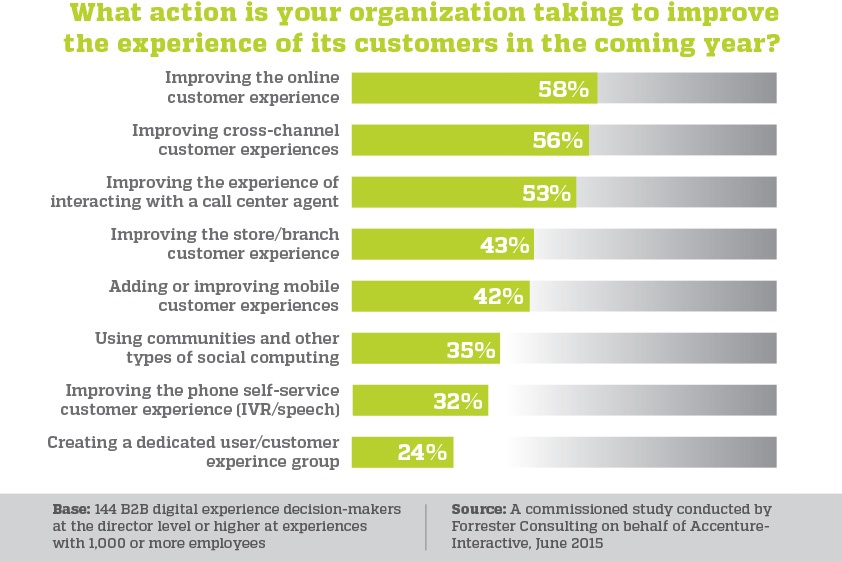 Digital and customer experience for B2B companies are becoming synonymous, and that's why an engaging and relevant digital strategy focuses on the customer.
Digital and customer experience for B2B companies are becoming synonymous, and that's why an engaging and relevant digital strategy focuses on the customer.
Assign the C-Suite Responsibility for Digital Strategy
In order to execute the digital strategy effectively, you'll need guidance from someone who's been assigned responsibility for the digital strategy.In some companies it's the CEO, in others it's a Chief Information Officer (CIO) or chief digital officer. Whatever the title, someone in the C-Suite must lead the company with their end vision, with any changes being a result of this end vision.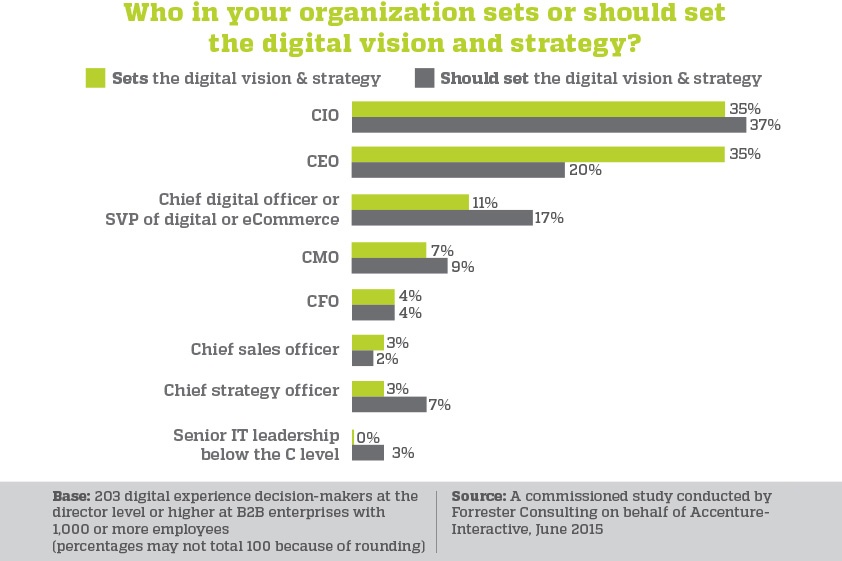 In order to capture and sustain the attention of millennial buyers, you'll need to involve the C-suite to align all parts of your business to provide value to the customer – whether R&D, HR and company culture, or sales.
An exceptional customer experience will reflect this alignment.
In order to capture and sustain the attention of millennial buyers, you'll need to involve the C-suite to align all parts of your business to provide value to the customer – whether R&D, HR and company culture, or sales.
An exceptional customer experience will reflect this alignment.















